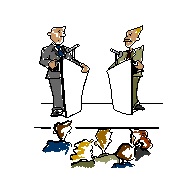Powerful Communication
Question and Answer time

Q &A sessions are important elements of a presentation. At the outset of the presentation, state when you would like to handle the questions. Preferably allot some time at the end of session. Answering questions is a good way to summarize the main points, clarify understanding, and reinforce your recommendations.
Make sure that you respond to the questions asked. While answering enthusiastically and positively, keep the answers focused and brief. Don’t shy away from admitting when you don’t know the answer. During the preparation phase, it makes sense to anticipate the kind of questions that may come up and plan suitable responses. 
So you have good questions, difficult questions, and unnecessary questions. The best way to buy time to handle a question is to repeat the question itself.
Good questions help you to reinforce or elaborate on your man points. Difficult questions often come from hecklers whose intention is to confuse you , embarrass or challenge you. You could choose to answer or avoid the question saying that you do not wish to comment on it. Irrelevant questions are those which ask about information that you have already given. You could respond to this by saying that it was already answered earlier.
How do you answer the questions? Start by listening carefully. If it is a question on elaboration of a point, be patient and answer. It is often best to repeat the question as it ensures that everyone hears it, and gives you time to formulate an answer. Maintain eye contact with the questioner, and also with the rest of the audience. Keep your answer brief, and understand the intent of the question asked. Don’t preempt a question and try to answer before a question is fully completed.
Be wary of questioners who ask questions only to seek attention or promote themselves. Be in control, and bring the focus back to the group and respond to repeated questions from the same person only once all other questioners have had their chance. Avoid giving predetermined answers to questions as this might be irritating and unfulfilling for the questioner. Avoid defensive answers as it is a sign of weakness.
And what if there are no questions from the audience? Turn the tables, pick a specific point from your presentation that could stimulate discussion and ask the audience about their views on it. Define topics for discussion – ask if anyone has questions on the concepts covered on the day.
The simple technique for answering is to first listen, then understand, next communicate and involve not just the questioner but the whole audience by paraphrasing the question before you respond.
Summary:
- Allot suitable amount of time for a Q&A session
- Answer sincerely and read audience intention behind the question.
- If there are no questions, then turn tables and ask them counter question from the presentation to check understanding.
Reflection Time

Prashant your colleague tends to get nervous during the question answer segment of the presentations. While he is otherwise well prepared, knows his content very well and speaks confidently, come Q &A time and his body language changes. He appears nervous, resorts to nervous tics and starts to use too many fillers.
This has happened any a time, and he now dreads having to handle this segment of the presentation. In fact, often the meekest of the audience responds in a hostile manner and challenge him since they see his nervousness. What would you suggest Prashant do? How would you advise him to handle hecklers and people who torment him with repeated irrelevant questions?
Copyright (c) Infosys BPO Limited and/or its licensors, 2014, all rights reserved